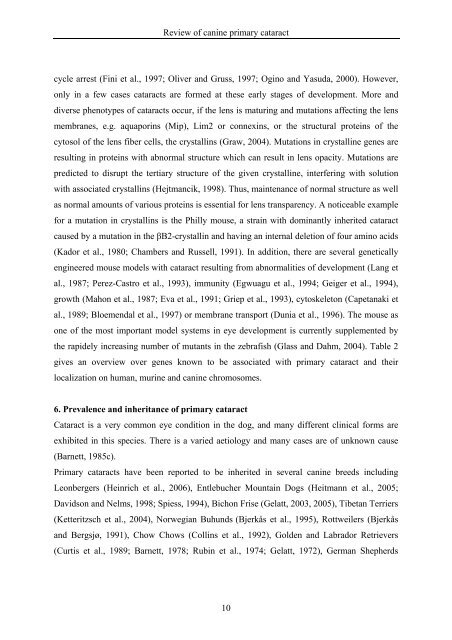Aus dem Institut für Tierzucht und Vererbungsforschung - Stiftung ...
Aus dem Institut für Tierzucht und Vererbungsforschung - Stiftung ...
Aus dem Institut für Tierzucht und Vererbungsforschung - Stiftung ...
Create successful ePaper yourself
Turn your PDF publications into a flip-book with our unique Google optimized e-Paper software.
Review of canine primary cataract<br />
cycle arrest (Fini et al., 1997; Oliver and Gruss, 1997; Ogino and Yasuda, 2000). However,<br />
only in a few cases cataracts are formed at these early stages of development. More and<br />
diverse phenotypes of cataracts occur, if the lens is maturing and mutations affecting the lens<br />
membranes, e.g. aquaporins (Mip), Lim2 or connexins, or the structural proteins of the<br />
cytosol of the lens fiber cells, the crystallins (Graw, 2004). Mutations in crystalline genes are<br />
resulting in proteins with abnormal structure which can result in lens opacity. Mutations are<br />
predicted to disrupt the tertiary structure of the given crystalline, interfering with solution<br />
with associated crystallins (Hejtmancik, 1998). Thus, maintenance of normal structure as well<br />
as normal amounts of various proteins is essential for lens transparency. A noticeable example<br />
for a mutation in crystallins is the Philly mouse, a strain with dominantly inherited cataract<br />
caused by a mutation in the βB2-crystallin and having an internal deletion of four amino acids<br />
(Kador et al., 1980; Chambers and Russell, 1991). In addition, there are several genetically<br />
engineered mouse models with cataract resulting from abnormalities of development (Lang et<br />
al., 1987; Perez-Castro et al., 1993), immunity (Egwuagu et al., 1994; Geiger et al., 1994),<br />
growth (Mahon et al., 1987; Eva et al., 1991; Griep et al., 1993), cytoskeleton (Capetanaki et<br />
al., 1989; Bloemendal et al., 1997) or membrane transport (Dunia et al., 1996). The mouse as<br />
one of the most important model systems in eye development is currently supplemented by<br />
the rapidely increasing number of mutants in the zebrafish (Glass and Dahm, 2004). Table 2<br />
gives an overview over genes known to be associated with primary cataract and their<br />
localization on human, murine and canine chromosomes.<br />
6. Prevalence and inheritance of primary cataract<br />
Cataract is a very common eye condition in the dog, and many different clinical forms are<br />
exhibited in this species. There is a varied aetiology and many cases are of unknown cause<br />
(Barnett, 1985c).<br />
Primary cataracts have been reported to be inherited in several canine breeds including<br />
Leonbergers (Heinrich et al., 2006), Entlebucher Mountain Dogs (Heitmann et al., 2005;<br />
Davidson and Nelms, 1998; Spiess, 1994), Bichon Frise (Gelatt, 2003, 2005), Tibetan Terriers<br />
(Ketteritzsch et al., 2004), Norwegian Buh<strong>und</strong>s (Bjerkås et al., 1995), Rottweilers (Bjerkås<br />
and Bergsjø, 1991), Chow Chows (Collins et al., 1992), Golden and Labrador Retrievers<br />
(Curtis et al., 1989; Barnett, 1978; Rubin et al., 1974; Gelatt, 1972), German Shepherds<br />
10










![Tmnsudation.] - TiHo Bibliothek elib](https://img.yumpu.com/23369022/1/174x260/tmnsudation-tiho-bibliothek-elib.jpg?quality=85)






